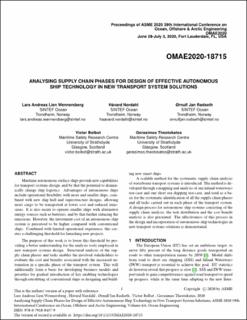| dc.contributor.author | Wennersberg, Lars Andreas Lien | |
| dc.contributor.author | Nordahl, Håvard | |
| dc.contributor.author | Rødseth, Ørnulf Jan | |
| dc.contributor.author | Bolbot, Victor | |
| dc.contributor.author | Theotokatos, Gerasimos | |
| dc.date.accessioned | 2021-04-28T12:01:08Z | |
| dc.date.available | 2021-04-28T12:01:08Z | |
| dc.date.created | 2020-12-22T17:45:06Z | |
| dc.date.issued | 2020-06 | |
| dc.identifier.citation | ASME 2020 39th International Conference on Ocean, Offshore and Arctic Engineering - Volume 6A: Ocean Engineering - OMAE2020-18715 | en_US |
| dc.identifier.isbn | 978-0-7918-8437-9 | |
| dc.identifier.uri | https://hdl.handle.net/11250/2740164 | |
| dc.description.abstract | Maritime autonomous surface ships provide new capabilities for transport systems design, and by that the potential to dramatically change ship logistics. Advantages of autonomous ships include operational flexibility with more and smaller ships, combined with new ship hull and superstructure designs, allowing more cargo to be transported at lower cost and reduced emissions. It is also easier to operate smaller ships with alternative energy sources such as batteries, and by that further reducing the emissions. However, the investment cost of an autonomous ship system is perceived to be higher compared with conventional ships. Combined with limited operational experience, this creates a challenging threshold for launching new projects. The purpose of this work is to lower this threshold by providing a better understanding for the analysis tools employed in new transport systems design. Structured analysis of the supply chain phases and tasks enables the involved stakeholders to evaluate the cost and benefits associated with the increased automation in a specific phase of the transport system. This will additionally form a basis for developing business models and priorities for gradual introduction of key enabling technologies through retrofitting of conventional ships or designing and building new smart ships. A scalable method for the systematic supply chain analysis of waterborne transport systems is introduced. The method is developed through a mapping and analysis of one inland waterways use-case and one short sea shipping use-case, and used as a basis for the systematic identification of all the supply chain phases and all tasks carried out in each phase of the transport system. A design process for autonomous ship systems consisting of the supply chain analysis, the task distribution and the cost benefit analysis is also presented. The effectiveness of this process in the design and incorporation of autonomous ship technologies in new transport systems solutions is demonstrated. | en_US |
| dc.language.iso | eng | en_US |
| dc.publisher | ASME | en_US |
| dc.relation.ispartof | ASME 2020 39th International Conference on Ocean, Offshore and Arctic Engineering - Volume 6A: Ocean Engineering | |
| dc.relation.ispartofseries | ;OMAE2020-18715 | |
| dc.title | Analysing Supply Chain Phases for Design of Effective Autonomous Ship Technology in New Transport System Solutions | en_US |
| dc.type | Chapter | en_US |
| dc.description.version | acceptedVersion | en_US |
| dc.identifier.doi | 10.1115/OMAE2020-18715 | |
| dc.identifier.cristin | 1862888 | |
| dc.relation.project | EC/H2020/815012 | en_US |
| cristin.ispublished | true | |
| cristin.fulltext | postprint | |
| cristin.qualitycode | 1 | |
